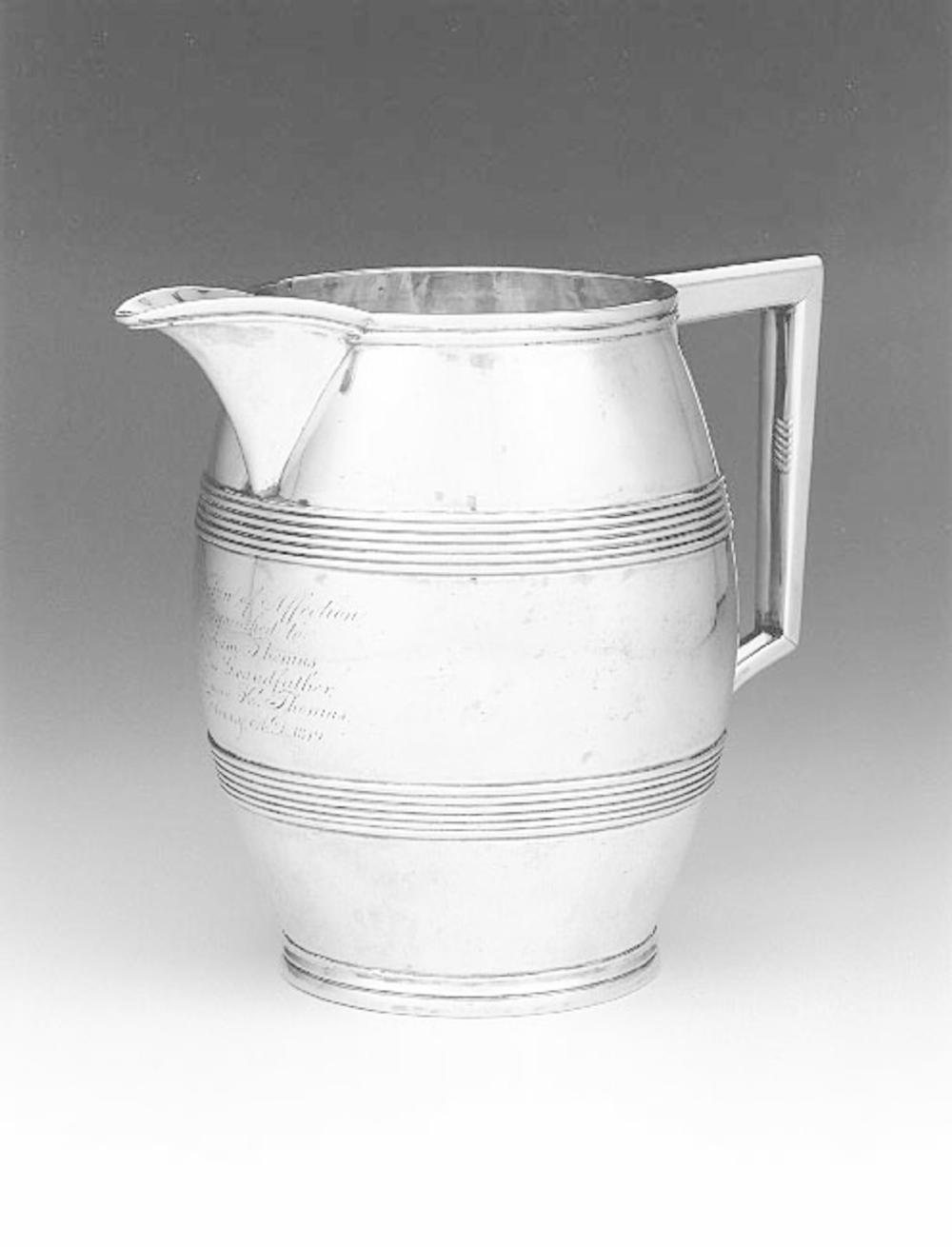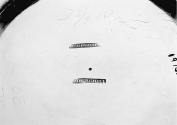Advanced Search
Pitcher
Jesse Churchill (American, 1773–1819)
about 1810
Object Place: Boston, Massachusetts, United States
Medium/Technique
Silver
Dimensions
Overall: 19.5 x 24 x 11.4 cm, 0.9 kg (7 11/16 x 9 7/16 x 4 1/2 in., 1.98 lb.)
Credit Line
Gift of Sargent Bradlee
Accession Number1973.411
NOT ON VIEW
CollectionsAmericas
ClassificationsSilver hollowware
Jesse Churchill belonged to the first generation of New England silversmiths to mature during the era of the new republic and the last generation to practice before the factory system and steam power began its slow but inevitable domination. The earliest documented objects bearing his mark are a flagon made about 1802 for the South Congregational Church in Andover, Massachusetts, and flagons and plates made in 1805 for the first Religious Society in nearby Newburyport. Churchill may have trained with Newburyport’s Moulton family of silversmiths and continued to work in the area as a journeyman. Boston’s Columbian Centinel (February 15, 1804) announced his January 13, 1804, marriage to Hannah Brown in Concord, Massachusetts.
Churchill’s first recorded appearance as a goldsmith in Boston was in the Tax Assessor’s Taking Books of 1808. The following year he was listed in the Boston Directory (published every two to three years at that time). Before launching his own Boston shop, Churchill may have had ties to Ebenezer Moulton (1768 – 1824), who relocated from Newburyport to Boston in the mid-1790s, the only one of his family to do so. This sturdy barrel-shaped water or beer pitcher is similar to two of Moulton’s barrel-shaped pitchers in the collection of the MFA. Churchill’s marks (like those of Moulton, Paul Revere, and Samuel Bartlett of Concord) appear occasionally with that of Boston silversmith Joseph Loring, who was known to retail the work of a few colleagues. About 1810, when this pitcher was made, Churchill also made a pair of matching barrel-shaped pitchers (plain, without reeded bands) that bear both his and Loring’s marks.
In 1808 Churchill’s shop was located at 88 Newbury Street in Ward 11, part of today’s Washington Street and east of the south end of Boston Common, between Essex and Summer streets. He lived on Pleasant Street, a few blocks west of the shop. The 1810 tax records note the presence of an assistant in Churchill’s shop, perhaps Elizur/Eleazur Holyoke, and a second shop in Ward 12 (its location is not given) with an assistant or apprentice. Also about this time, Daniel Treadwell arrived in Boston to finish his apprenticeship with Churchill after the failure of his brother’s shop in Ipswich, Massachusetts, in 1809. A pair of flagons and a basin dated 1811, made for the West Boston Society or “West Church” built in 1809, bear Churchill’s mark. His shop remained at the Newbury Street address in 1813, and his home was at Newbury Place. Treadwell and Holyoke were listed as journeymen silversmiths living at Newbury Place, presumably with Churchill.
During the autumn of 1813 and spring of 1814, the Churchill shop produced the silver presentation service of more than three dozen hollowware pieces that was commissioned by citizens of Boston for Comm. Horatio Oliver Perry, hero of the battle of Lake Erie (see cat. no. 141). Each piece bears the mark “Churchill & Treadwell.” In 1816 the partners produced an elaborate presentation urn for Boston Masonic chaplain Thaddeus M. Harris, probably the most ambitious object of their careers. Despite the firm’s success, sometime before 1817 Treadwell left the silversmithing profession to forge a career as an inventor and, eventually, to become a professor at Harvard College.
A respected member of the community, Churchill was one of the appraisers of Joseph Loring’s estate in 1815. Loring’s executors also made two payments to Churchill for earlier work, indicating that Churchill continued to wholesale goods through Loring after 1810. The tax records indicate that Churchill was working with three unnamed apprentices in 1817, with his shop now on Marlboro Street in Ward 8. He made two flagons in 1817 and 1818 for the Church of Christ in Bedford. In 1818 Churchill’s shop moved again, to 8 Hawley Place. Little else is known of his life before his death in 1819. The modest value of his estate inventory suggests that much was sold or lost to creditors before his death.
This text has been adapted from "Silver of the Americas, 1600-2000," edited by Jeannine Falino and Gerald W.R. Ward, published in 2008 by the MFA. Complete references can be found in that publication.
Churchill’s first recorded appearance as a goldsmith in Boston was in the Tax Assessor’s Taking Books of 1808. The following year he was listed in the Boston Directory (published every two to three years at that time). Before launching his own Boston shop, Churchill may have had ties to Ebenezer Moulton (1768 – 1824), who relocated from Newburyport to Boston in the mid-1790s, the only one of his family to do so. This sturdy barrel-shaped water or beer pitcher is similar to two of Moulton’s barrel-shaped pitchers in the collection of the MFA. Churchill’s marks (like those of Moulton, Paul Revere, and Samuel Bartlett of Concord) appear occasionally with that of Boston silversmith Joseph Loring, who was known to retail the work of a few colleagues. About 1810, when this pitcher was made, Churchill also made a pair of matching barrel-shaped pitchers (plain, without reeded bands) that bear both his and Loring’s marks.
In 1808 Churchill’s shop was located at 88 Newbury Street in Ward 11, part of today’s Washington Street and east of the south end of Boston Common, between Essex and Summer streets. He lived on Pleasant Street, a few blocks west of the shop. The 1810 tax records note the presence of an assistant in Churchill’s shop, perhaps Elizur/Eleazur Holyoke, and a second shop in Ward 12 (its location is not given) with an assistant or apprentice. Also about this time, Daniel Treadwell arrived in Boston to finish his apprenticeship with Churchill after the failure of his brother’s shop in Ipswich, Massachusetts, in 1809. A pair of flagons and a basin dated 1811, made for the West Boston Society or “West Church” built in 1809, bear Churchill’s mark. His shop remained at the Newbury Street address in 1813, and his home was at Newbury Place. Treadwell and Holyoke were listed as journeymen silversmiths living at Newbury Place, presumably with Churchill.
During the autumn of 1813 and spring of 1814, the Churchill shop produced the silver presentation service of more than three dozen hollowware pieces that was commissioned by citizens of Boston for Comm. Horatio Oliver Perry, hero of the battle of Lake Erie (see cat. no. 141). Each piece bears the mark “Churchill & Treadwell.” In 1816 the partners produced an elaborate presentation urn for Boston Masonic chaplain Thaddeus M. Harris, probably the most ambitious object of their careers. Despite the firm’s success, sometime before 1817 Treadwell left the silversmithing profession to forge a career as an inventor and, eventually, to become a professor at Harvard College.
A respected member of the community, Churchill was one of the appraisers of Joseph Loring’s estate in 1815. Loring’s executors also made two payments to Churchill for earlier work, indicating that Churchill continued to wholesale goods through Loring after 1810. The tax records indicate that Churchill was working with three unnamed apprentices in 1817, with his shop now on Marlboro Street in Ward 8. He made two flagons in 1817 and 1818 for the Church of Christ in Bedford. In 1818 Churchill’s shop moved again, to 8 Hawley Place. Little else is known of his life before his death in 1819. The modest value of his estate inventory suggests that much was sold or lost to creditors before his death.
This text has been adapted from "Silver of the Americas, 1600-2000," edited by Jeannine Falino and Gerald W.R. Ward, published in 2008 by the MFA. Complete references can be found in that publication.
DescriptionTwo reeded bands divide the barrel-shaped body of the pitcher into three sections. Graduated two-part rounded molding is applied at the upper rim of the body and inset V-shaped spout. The angular three-part hollow handle is attached at the rim and lower midsection. The handle is square in section with beveled corners. The pitcher rests on an applied and molded base.
Marks
"CHURCHILL" within a rectangle struck twice on bottom
Ada Mark * F4418
Ada Mark * F4418
Inscriptions"A Token of Affection, / bequeathed to / Gorham Thomas / by his Grandfather. / Thomas K. Thomas. / February A.D. 1849" in script engraved under spout
ProvenanceThomas Kemble Thomas (b. 1771); to grandson Gorham Thomas (b. 1831); through the Thomas family to Elizabeth Whitwell Thomas (b. 1868) and her husband, Frederick Josiah Bradlee; to their son Sargent Bradlee (1898 – 1987), the donor.



